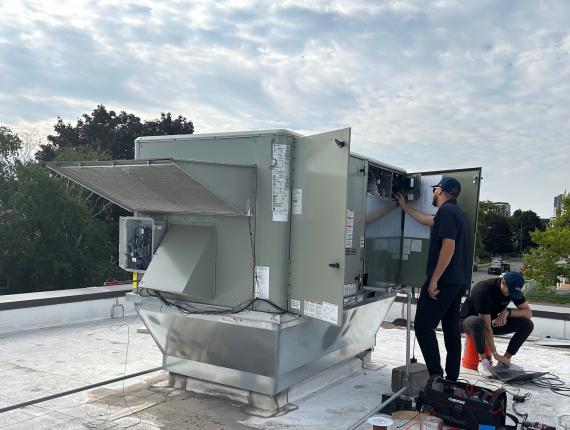Next Gen Rooftop Units
Next gen rooftop units save energy and carbon while lowering energy bills with heat pumps and energy recovery ventilators.

Next gen rooftop units (RTUs), formally known as high-performance RTUs, are packaged heating and cooling units that use energy efficient technology to effectively heat and cool a commercial space, reducing energy consumption and emissions. Heat pump technology and energy recovery ventilators (ERVs) are two examples of technologies that can contribute to a next gen RTU.
A dual fuel heat pump RTU can provide both heating and cooling to a building using one refrigeration system. These systems are like a traditional air conditioning RTU but can reverse the flow of refrigerant to move heat from the outside environment into the building. Heat pumps are much more efficient than gas furnaces because they move heat from one location to another instead of generating heat by combusting natural gas.
RTUs transfer fresh outdoor air into the building while exhausting indoor air that has collected volatile organic compounds, pollutants, and dirt. While this is necessary, it comes with a significant energy penalty if an ERV is not used. The ERV exchanges heat and moisture between the incoming fresh outdoor air and exhausted indoor air. By conditioning the incoming fresh air, an ERV saves energy by reducing the amount of heating and cooling the building needs.
The primary benefits of next gen RTUs lie in the ability to efficiently heat, cool, and ventilate commercial and industrial buildings through existing ductwork. Dual fuel heat pump RTUs significantly reduce building energy use, and therefore emissions, while also providing a backup heat source for very cold temperatures. Heat pump RTUs can replace existing, older RTU equipment, without significant impact to the building and can cut HVAC energy use by over 50%. Dual fuel heat pump RTUs provide resiliency with two energy sources for heating and decrease demand charges for electrical utility bills during peak heating demand. They also offer alternative heating solutions when gas or electric prices fluctuate.
ERVs condition incoming air, balance humidity, and enhance comfort for building occupants. This significantly reduces energy use and can reduce the tonnage of HVAC system required because the incoming fresh air does not need to be heated or cooled to the same extent. ERVs can be easily added to existing RTUs as a bolt-on feature, and some RTUs have ERVs integrated into the unit.
Advancing the performance of RTUs is crucial to meet the growing demand for energy efficient and sustainable building solutions. Because of the lack of significant changes in the RTU market over the past 30 years, improving their performance remains an often overlooked strategy to reduce energy use. Around 60% of energy consumption in commercial buildings stems from HVAC equipment, highlighting the importance of optimizing RTU efficiency. In Minnesota, 80% of commercial buildings rely on RTUs for heating and cooling, with 97% of these systems utilizing gas heat. Transitioning to next gen RTUs would not only decrease energy consumption but also significantly reduce emissions.